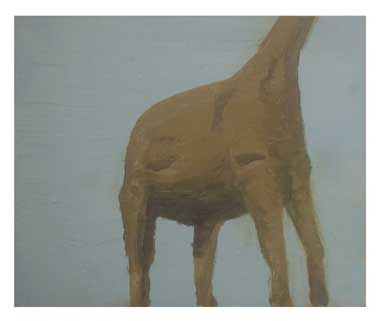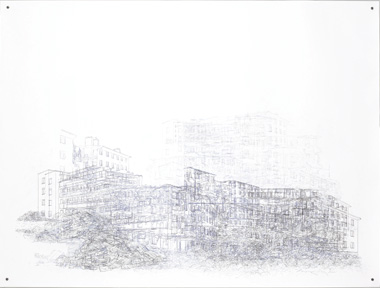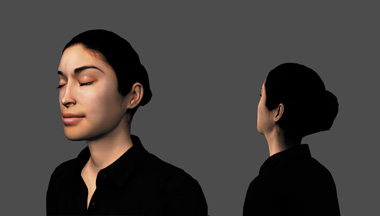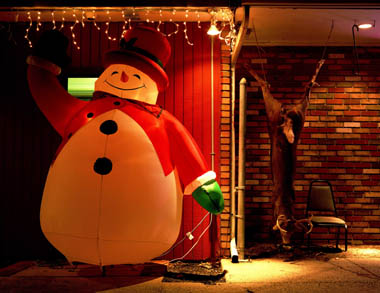This last exhibition in the series of emerging Irish artists’ work presents a peculiar concoction of old and new wealth ‘documenting’, which is to say presiding over, a rather disparate selection. Before any discussion of the works themselves can begin, the processes of selection and presentation might be considered. ‘To document’ is a rather neutral verb, and its use obscures the very active role being played by both the RHA and Eurojet in determining what art is ’emerging’ in Ireland.
‘Innovative and enthusiastic sponsorship’ of young artists is now a common means by which a corporation gains kudos and positive publicity resulting from their image as a benign patron. More importantly though, such patronage often searches for what already has the look of ’emerging’ art: in order to gain kudos, corporate patrons must make a show of their ‘daring’ and ‘innovation’ whilst not departing too far from what is deemed proper practice. So, there is conservatism at the heart of corporate innovation: a conservatism dictated, above all, by the axiom of capital accumulation. A recurrent practice among arts institutions is importing the kind of ‘institutional critique’ that, paradoxically, ratifies the hierarchy of institutional structures. When an institution takes such calculated ‘risks’ it not only presents itself as less stuffy and more ‘accessible’ than was thought, it also pre-empts certain forms of criticism by contracting them to the institution itself.
 |
| Sonia Suominen: Podium, 2004, c-type print on diabond, 102 x 127 cm’; courtesy RHA gallery |
The photographs of Sonia Suominen show behind the scenes at the RHA as it prepares for exhibitions. We see images of canvas frames stacked against a wall, of dimly-lit corridors and back doors, of storage spaces, and of the gallery space itself cluttered with the tools of installation. Is this deconstruction of the white cube, as it is claimed to be? Deconstruction is a textual strategy that seeks to loosen rigid linguistic structures, and to stretch the internal semantics of these structures until the seams begin to show. At these seams we might discern otherwise hidden or disavowed presuppositions, and what traces of production are excluded when language is framed apart from its context. With visual art, this textual strategy has been used, not least, to put pressure upon many of the ‘frames’ used to present art to the world and to re-introduce heterogeneity into a restrictive formalist tradition. Foremost among these ‘frames’ has, of course, been the blank abstraction of the white- cube gallery space. Having looked behind the scenes, however, Suominen resituates her findings squarely back within the white cube. If the white cube is a life-erasing, sterile environment with transcendental ambitions, its antithesis is the clutter and unpredictability of life as it is lived. Suominen’s photographs show no human activity, only its well-composed traces: life is erased and production lacks any human physiognomy. Furthermore, these photographs are presented, in the white cube of the RHA gallery, with familiar formality. This is not a process of deconstruction but one of reformulation, in which the white cube absorbs the possible disruption of clutter by repackaging what it disavows in its own conceptual terms.
 |
| Ciaran Murphy: Untitled, 2004, oil on stretched paper, 20 x 24 cm; courtesy RHA gallery |
Ciarán Murphy’s series of small paintings makes no grand claims, approaching its subject obliquely and with hesitation. Their serial spacing suggests something of an imaginary travelogue as one moves from one to the other. Fantastic and familiar beasts encountered in uncertain, alien habitats populate this brief display. Nature is experienced second-hand, and is all the stranger for it: but perhaps in the associations that such strangeness encourages we encounter nature more directly, if negatively; perhaps nature is not, after all, alienated by our self-enclosed artifice, but this artifice is indeed nature’s ‘final fruit’.
 |
| Julie Merriman: Dis-Location: Block G, Fatima Mansions, Oct ’03, 2004, carbon on paper; courtesy RHA gallery |
Julie Merriman’s drawings are indeed ‘beautifully constructed’, but more than construction they show the celebrated dissolution of the modernist edifice as it is rotated about multiple axes, disintegrating into a web of multidirectional lines. As constructions, her drawings are built upon this dissolution. For Merriman, the collapse of the International Style is not an occasion for mourning, rather an opportunity to encounter new forms: destruction is often spectacular. But the transition from the utopian strictures of functionalism to the knots of postmodern plurality is not simply a change of form, if it is a transition at all and not simply modernism becoming conscious of the fact that its edifices were originally built upon contradictory forces. The monotony of Merriman’s line and the overall equivalence of her attention suggest that what appears to be different may be, for her, the same. When Merriman returns to the original form of the blueprint, she commits the same mistake of formalist detachment that might be levelled at the original planners. To insist on a formal reading for this work contains a particular charge at a time when drastic cuts are being made in social housing and the idea of any progressive vision is given over to the ‘pragmatics’ of the market.
Nevan Lahart “lampoons the art world and powers that be" with a hotchpotch of paintings, animations and sculptures, and he certainly seems to be enjoying himself. His works bring some welcome bite and directness to the exhibition, and it is good to hear the occasional snigger in the sacred spaces of art. When lampooning the ‘powers that be’, Lahart’s enemies are the usual triumvirate: the Pope, George Bush’s administration, and their resident lapdog, Tony Blair. Lahart attacks them with the ocassionally frank but often guarded wit of a court jester. However, satire must hit the weak points of its enemy, and it is debatable how often Lahart does so. For example, there is little ground to be made by making the connection between the Papacy and violence, or between the Bush administration and its imperial ambitions, especially when the latter is so open in its intentions (see e.g. www.newamericancentury.org ). Where Lahart makes binary divisions and employs stereotypes, he repeats, and therefore validates, those of his enemies by simply inverting them: subversion here reiterates that which it seeks to subvert, or in other words, subversion remains subordinate to the ‘powers that be’. It is not that Bush and his administration are somehow aberrant, or a corruption of a benign system: the flaws are structural and ideological, not personal. If Lahart was to look a little closer to home he might find less comfortable targets: the Irish government itself becomes part of the ‘coalition of the willing’ that has invaded Iraq, when it allows the US military to use Shannon airport. When Lahart picks foreign targets this displaces this complicity, but this is an impossibly neutral position at present. As the Wombles remind us, the revolution starts small, but it also starts at home.
When lampooning the current art world, rather than art history, Lahart’s satire is rather blunted by the fact that he has been selected by the art establishment to show that they can laugh at themselves, just so long as it does not upset things. This reminds one of the masochistic titillation Charles Saatchi evidently receives from buying works that directly ‘lampoon’ him, thereby pre-empting any serious or cutting criticism of his patronage, by making artists beholden to his financial support. Furthermore, what institutions need are illustrations of political discontent and criticism. This keeps both at a safe distance and confines them to manageable forms. Lahart, for all his discontent, remains defined by the artistic conditions that he makes use of. The apparatuses by which he illustrates what is undoubtedly a necessary political criticism are increasingly common in both their format and display. At the rare moments in the past when art has avoided political illustration, it has carried a “message that cannot be disentangled from the techniques that are used to deliver it; techniques that are improvised, unlikely, extreme; techniques that tear down a discipline … from within" (T J Clark). A pictorial violence is required: one that cannot be so easily repackaged. Lahart occasionally commits this violence – and laughter, of course, is a form of violence when it happens in a gallery space – but it is as yet rather sporadic.
 |
| John Gerrard: Watchful portrait (Caroline), 2004; courtesy the artist |
John Gerrard’s Watchful portrait (Caroline) (2004) is fascinating in its technical expertise, and, in terms of portraiture, in its physical likeness. However, the slight distortions in shape, and the delay in response when one manipulates the screen, never allow the image to escape the uncanniness of its technology, precluding the screen becoming a window on another world. This insistence on objecthood undercuts the coherence of the image: the lie that is simulation and representation cannot be concealed. It is this disturbance that reinforces the irreconcilable gap between the body in the world and the technology of representation: a gap that is also an attachment, refusing the total transformation of the body into a virtual entity.
It seems rather misleading then to imbue ‘Caroline’ with the appearance of interior mentality, such as her ‘primordial fascination’ with the passage of the sun and moon. This appearance of interiority disguises the absence upon which the portrait is based: it reinstates personality where it can only be simulated. In The great flood (1997) a lack of interiority is clearly evident in the drone-like figure with a nosebleed. But in this the disguise works the other way; the flood neutralises personality rather than simulates it, so that even the authenticity of blood as the final sign of life is doubted. The great flood suggests a rather more dystopian vision of technological advancement and dissemination than that given by Caroline: one of passive absorption in the flood of media imagery.
 |
| Martin Healy: Jersey Devil Incident (I looked out and it was standing in the middle of the yard staring at me), 2004, photographic transparency in lightbox, 76 x 102 cm’; courtesy RHA gallery |
Lastly, Martin Healy documents the myth of the Jersey Devil, a spectral beast reported to live in the Pine Barons forest of New Jersey in the USA. The narrator of Healy’s video piece talks of a ‘strange presence’ and of consistent reports of a shadowy dog-sized horse with wings and horns. Where there are shadows there will always be monsters, and those willing to be ‘terrorised’ by them. The projection of fears upon a mythical object or creature is also a displacement of responsibility and an excuse for one’s own violence and domination, whether that be domestic or in the wilds. One of Healy’s photographs from a site where the Devil was sighted shows a roadside barrier with ‘innocence lost’ spray-painted upon it; it would be more accurate if it said ‘innocence regained’.
Tim Stott is an art critic living in Dublin.